ALL NEW FOUNDATIONAL INTELLIGENCE MODEL (FICE) - Get your Insights Report Here
Alex Luna • January 30th, 2023.
Soil is more than “dirt:” It consists of mineral particles, organic materials, air, water, and living organisms — all of which interact slowly yet constantly. Formed from the weathering of rocks, soil is an essential nonrenewable resource, and managing it properly enhances its performance. Without sustainable soil management practices, soil can become degraded, eroded, compacted, toxic, and/or inhospitable to life. This risks fertility, biodiversity, water health, and more. The importance of soil sustainability cannot be overstated in terms of utility, resources, and climate. It is key for food access, ecosystem services, and livelihoods.
Want to learn more about the risks soil can soil pose? Download our e-book, Soil: The Hidden Risk to Your Business and How to Manage It, The 2023 Guide, to see why and how business leaders at the world’s top companies are taking control of their soil risks and planning for the future.
Soil sustainability is crucial to life on Earth. Healthy soils are full of life, as it provides the habitat for countless living organisms, from microorganisms like bacteria, fungi, and algae, to fauna like earthworms, mites, insects, and burrowing rodents. Soil contains minerals and organisms, constantly interacting with all matters in touch. It produces food, purifies water, protects against disasters, and combats drought.
Soil holds the largest portion of active carbon on Earth and supports the global carbon cycle (which interacts with other important chemical cycles like nitrogen, phosphorus, and sulfur). Carbon in soil builds its fertility, water-retention capacity, and structure. In addition, plants require water from the soil, carbon from the air, and sunlight to create oxygen that humans need. This highlights the importance of preserving soil through sustainable farming.

Soil is complex and serves many functions. It not only acts as a water filter and a growing medium but also provides a habitat for billions of organisms, contributing to biodiversity. Soil supplies most of the antibiotics used to fight diseases. It also helps track climate change. Soil puts food on our plates, cleans our water, protects our properties against flooding, and combats droughts. So, what is the sustainable use of soil?
According to experts Abbott and Murphy (2007), soil management means meeting the needs of the present without compromising the ability of future generations to meet their own needs from that soil. Soil sustainability has been important for centuries, but the advancement of technology and population growth has been a double-edged sword. Intensive agriculture, urbanization, and climate change have damaged soils. We must work on soil conservation, soil quality, and soil health to protect soils. Sustainable forms of soil use help naturally stabilize the climate and ensure resilient supply chains, especially for food security. Aspects of soil sustainability include enhancing soil organic matter (for nutrient cycling), upgrading land management practices (to boost carbon sequestration capacity), preventing erosion (with cover-cropping soil surfaces and crop rotating), and reducing harmful chemicals (to avoid contamination and vegetation loss).
Soil quality refers to soil’s ability to perform ecosystem services to support life; in particular, soil fertility means soils can sustain agricultural plant growth. Sustainable soil management practices that keep soils healthy — with proper nutrient cycling and water filtration — help fertility, which improves crop yields, reduces the need for chemical fertilizers, and saves money.
Soil conservation maintains soil’s status as Earth’s largest water filter. Soil captures, absorbs, and cleans water via chemical, biological, and physical processes. Microorganisms can help transform, detoxify and/or decompose certain chemicals and contaminants in the soil. Also, soil composition (porosity, particle size) determines the physical water drainage of the soil. Soils with larger particles have larger holes to filter water through them, increasing water storage capacity and preventing soil from drying out.
Soil provides food and shelter for countless living organisms, including humans. It is not only the main habitat of billions of microorganisms, fungi, plants, and animals, but also the origin of commodities that provide us with food, fiber, and fuels. Soil sustainability means maintaining soil to grow soil-borne materials (timber, clay bricks) to build shelters and natural fibers and dyes for clothing and furniture. Additionally, fossil fuels from underground provide fuel for energy.
Contaminated, polluted soils can cause toxic chemicals to accumulate in nearby plants, animals, humans, and/or water sources, with effects from decreased crop yields to human sickness. Pollution can come from mining and industrial chemical leakage, chemical fertilizer overuse, improper municipal water treatment/waste management, and more. Better water filtration and sustainable soil management practices can create a cleaner, healthier world.
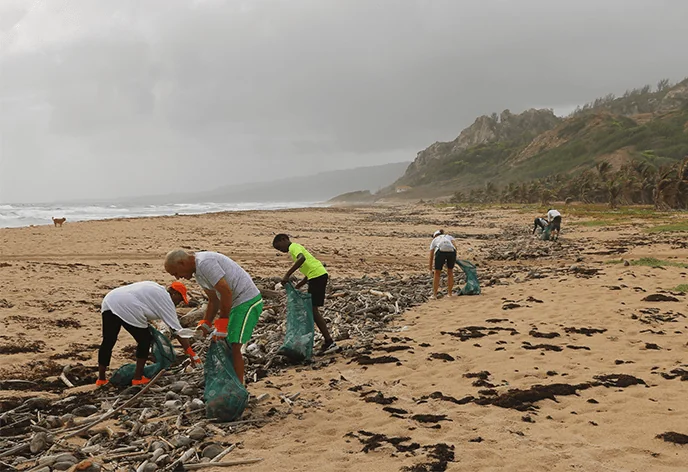
Soil plays a crucial role in the economy — especially for farming and agricultural production. The increased production from clean, healthy soil helps the economy by providing more resources, from crops to feed the population to timber to build their homes to fabric to clothe them. Sustainable soil use ensures that the environment and the economy are able to thrive. Still, it’s hard to measure in dollar values.
Research found that due to erosion and pollution, one-third of all arable land has been lost, much more quickly than natural processes will replace it. Subsequently, farmers/ranchers and developers convert other land like grasslands or forests into farmland, releasing stored greenhouse gases. Sustainable soil management can help slow or halt this degradation: Better soil management results in greater land preservation, as functioning arable land can be used every season.
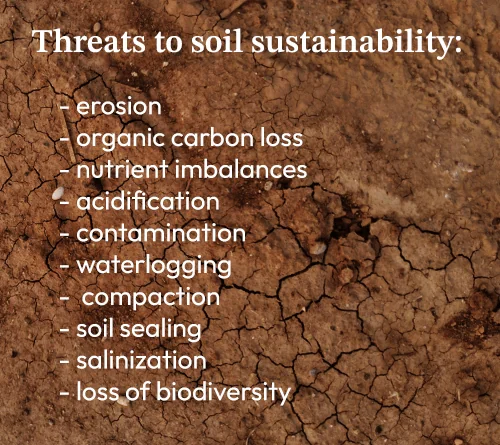
Some agricultural practices place significant pressure on the environment, especially soil health, which in turn affects the global climate cycle. Unsustainable soil management practices can release excess greenhouse gases like carbon dioxide that contribute to climate change. On the other hand, sustainable soil use, like restoring degraded soil and using soil conservation practices in agriculture, can store carbon in the ground, helping build resilience to the effects of climate change. Additionally, practices like capturing methane from manure, more efficient use of fertilizers, and greater efficiency in meat and dairy production can also reduce emissions.
Chemical contamination results from improper disposal of hazardous chemicals, such as from the excessive use of pesticides. It can impede soil sustainability, harms and contaminates soil, and hurts vegetation and nearby water sources. Additionally, these chemicals harm biodiversity and animals. One study found that pesticides and chemicals used on soil and plants reduced grassland bird populations by over 50%. This also poses a big issue for water management. Sustainable soil management practices, such as natural or integrated pest and fertilizer management, can help combat it.
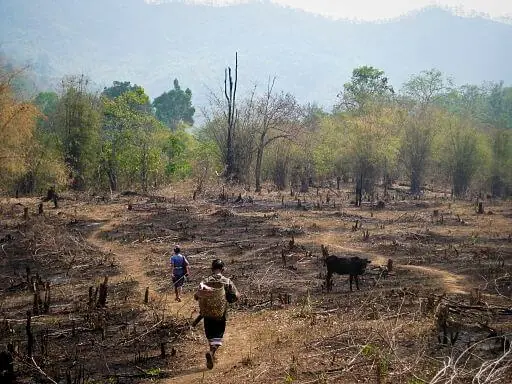
Slash and burn farming refers to the burning and clearing of forests to make way for farmland. Farmers cut down plant species in woody areas, killing them and removing wildlife from their natural habitats, to create a nutrient-rich layer of ash for fertile soil. But slash-and-burned lands are only used for a short time, because after 3-5 years, they lose fertility as nutrients are depleted and it’s more vulnerable to weed and pest invasion. This agricultural method does not work for soil conservation.
Land resources are often exploited and overused, due to factors including deforestation, increased populations, poor land use, insecure land tenure, improper land management practices, and poverty, according to the FAO. As forests and woodlands are cut for timber, and pastures are overgrazed, soil is exposed to increased erosion. This results in land losing its arability, putting it at risk of becoming a desert. The global climate cycle is impacted by soil overuse. This highlights the importance of preserving soil through sustainable farming.
Soil erosion is the degradation of the upper layer of soil, either from natural processes or human activity. It occurs when this soil is left exposed to strong winds, hard rains, and flowing water, sometimes due to human activities like farming and land clearing. One paper found that the estimated annual cost of soil erosion to global GDP is USD$8 billion. Plus, global food production can be reduced by 33.7 million tonnes; countries with eroded soil have a worse competitive advantage in world markets. Soil sustainability and soil conservation can help mitigate soil erosion, as sustainable management practices can reduce the impacts of human activity. This prevents soil degradation and erosion and the loss of valuable land to desertification.
Sustainable farming techniques help against erosion. There are some common tips to stop soil erosion. For one, don’t leave soils bare. Also, watch out for overgrazing. You could consider adding a buffer strip, using agroforestry systems, and using intercropping and/or cover cropping. In addition, one major key to managing and reducing soil erosion is to try to rehabilitate already-damaged land. Sustainable soil management practices are wide-ranging and must fit the agricultural landscape, a farmer’s needs, a location’s circumstances, and more
Soil sustainability is tied to economic development in several ways. Economic growth means more population and growing food consumption, which increases demands on agricultural land. Farmland as a natural resource is subject to environmental shocks, which are projected to become more severe due to climate change. On the other hand, soil sustainability helps economic development to meet the U.N. Sustainable Development Goals (SDGs): 17 goals focused on providing a “sustainable future for all.” In particular, it touches on – SDG 6 (Clean Water and Sanitation), SDG 13 (Climate Action); and SDG 15 (Life on Land). For SDG 6, healthy soil provides water filtration. With SDG 13, it also sequesters carbon, mitigating emissions and pushing for climate action. For SDG 15, it also supports healthy plant and animal life.
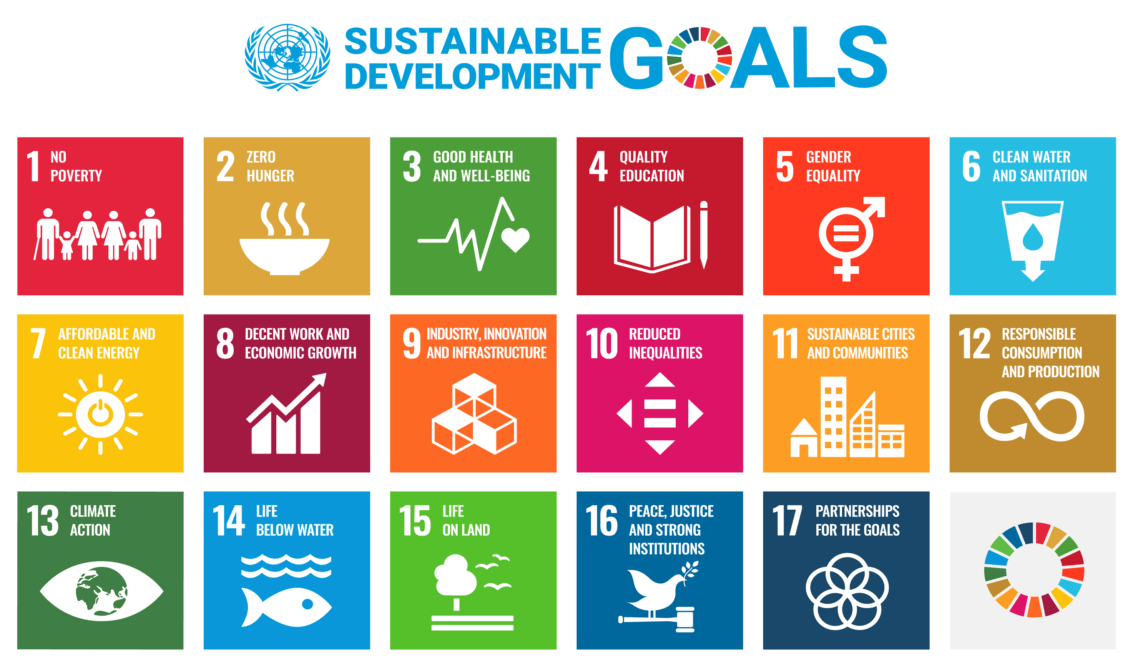
There are many ways to promote sustainable uses of soil. Sustainable soil management practices including reducing tillage, planting cover crops, improving crop rotations, and adding organic matter can promote healthy soils and more resilient crops. Some sustainable soil use examples include the FAO’s work with over-exploited Indian tea plantations to restore soil fertility and enhance productivity with earthworms and organic fertilizers. Another is in Egypt’s Nile Valley’s cotton growing, where FAO trained farmers on organic farming to support soil health and biodiversity.
The Convention on Biological Diversity (CBD) defines soil biodiversity as “the variation in soil life, from genes to communities, and the ecological complexes of which they are part, that is from soil micro-habitats to landscapes.” As mentioned above, this life that exists within the soil keeps soil healthy and fertile. Soil biodiversity plays a vital role in mitigating climate change, storing and purifying water, providing antibiotics, and preventing erosion. Sustainable soil management techniques keep this life in the ground and support the diverse organisms living there that feed on soil organic matter and fresh plant residues.
The definition of sustainable soil use is varied, but what sustainable soil use means is using the soil in a way that builds healthy soil, reduces erosion, and reduces the need for environmentally degrading inputs. New tech makes it easier to manage soil, but can also be hard because that means we use more land. That means we must also help rehabilitate unhealthy soil in order to restore the complete mineral nutritional values of the soil. That includes the restoration of the soil’s biochemical and physical properties, such as the carbon forms of soil acid gels, in the form of humic and fulvic acids to the soil.
Farming is a vital activity to feed the world’s growing population of nine billion people. As climate change threatens the productivity of food production, the sustainable use of soil is one of the biggest opportunities to ensure that we maintain agricultural production. Agriculture’s efficiency depends on soil quality — focusing only on farming without looking at soil sustainability will quickly deplete the nutrients needed to grow crops. Healthy soil is the foundation of productive, sustainable agriculture. Examples of sustainable soil use are plentiful — good, sustainable farming techniques help soil be more resilient, healthy, and productive, and reduce erosion for future use.
Some common soil conservation methods have already been touched on above, but we will go into more detail below with sustainable soil use examples. These methods include avoiding till farming, terrace farming, contour farming, rotating crops, restoring wetlands, windbreaks, restoring forest covers, and using earthworms.
In “tilling” farming, farmers use tools to turn over the first 6-10 inches of soil in their fields before planting new crops. Avoiding it means growing crops or pastures without disturbing the soil through tillage. This has several co-benefits: keeping soil structure intact by leaving plant parts like roots in the soil; increasing organic matter and supporting microorganisms; helping water filter through the soil; and reducing soil erosion/runoff. Soil can better absorb water, too, preventing pollution from entering nearby water sources. This boosts irrigation efficiency, ultimately leading to higher yields. Overall, a healthy, sustainable soil biome is important for nutrient cycling, suppressing diseases, and increasing the soil’s capacity.
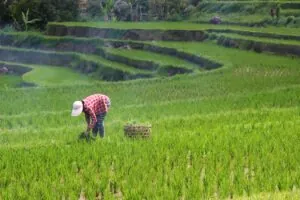
Terrace farming refers to growing crops on hills or mountains by essentially building surface steps into the side of a slope (sometimes called step farming). It’s often used for rice, a thirsty crop that likes flooded fields. One type of terrace farming is bench terracing, when the hills are cut into regularly spaced wide flatlands. What contributes to soil sustainability here is each terrace self-contains water, decreasing long-term soil erosion. One example is the Banaue Rice Terraces in the Cordilleras Mountains in the Philippines, which are a UNESCO World Heritage Site because the native Ifugao people have farmed them for 2,000 years.
Contour farming is the agricultural practice of plowing across a slope planting across a slope following consistent elevation contour lines. This conserves land along lines of consistent elevation in order to conserve rainwater, reduce soil erosion, and decrease fertilizer runoff. It can be most effective when used together with other practices such as strip cropping, terracing, and water diversion — and when done right, is one of the most sustainable forms of soil use. It is often used in vineyards and tree or fruit orchards. For example, Linvilla Orchards in Media, PA, uses contour farming in its raspberry fields.
The practice of crop rotation means switching off the type of plants grown in a field in a certain sequence varying by growing seasons. Changing crops that have different characteristics, such as nutritional profiles and disease/pest pressures, is key to reducing soil depletion and cutting greater pesticide and fertilizer use. It can also enhance biodiversity, improve soil fertility, and increase soil organic carbon. As a sustainable soil use example, after planting crops that fix nitrogen in the soil one season, you could plant crops that use a lot of nitrogen the next season. Farmers often rotate several different crops in succession.
Wetlands provide key ecosystem services such as helping control floods and preventing the waterlogging of crops. Restoring them and their sustainable uses of soil preserves and protects aquatic resources by retaining the natural structure and natural function of wetlands that have been degraded. Managers work within the watershed/landscape context, understand the potential of the watershed, and address ongoing causes of degradation. For example, 90% of the San Francisco Bay’s wetlands were lost due to human activity. Scientists and policymakers restored them by planting native marsh grasses at the right elevations and then breaching levees to flood the restored area. Then, native wildlife species were reintroduced.
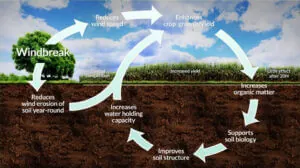
Windbreaks are natural or manmade barriers that reduce or redirect wind, a key component of sustainable soil management practices. They prevent wind from eroding soil — reducing the drying, abrasive impact of wind on soil/growing plants. For example, farmers will often use field windbreaks around their farmland to protect their crops from wind and increase pollination. They can serve a dual purpose of also trapping winter snow to use as a source of water in the spring. Another type is a livestock windbreak which helps reduce livestock mortality from cold weather, animal stress, and feed consumption, plus increasing livestock size and milk production.
Restoring forest ecosystems can reverse soil degradation and provide essential ecosystem services. Deforestation and development have destroyed many forests, so planting native trees and improving soil health can conserve wildlife and protect soils and water sources that are part of the forest ecosystem. It helps control invasive species, protects biodiversity, and improves soil sustainability. One example is the South Korean government’s initiative to plant fast-growing trees, establish fuel-wood forests, and conserve remaining forests. It increased its forest cover from 35 to 64% of the total land area between 1953 and 2007.
Earthworms are very important in soil ecosystems. They serve an important function in breaking down dead organic matter. Then bacteria and fungi can feed on it and release the nutrients from dead plants/animals, making them available for use by living plants. Earthworms also burrow in the soil, which mixes soil layers and incorporates organic matter throughout, improving soil fertility. Practices like applying more manure to agricultural fields, which adds additional organic material and nutrients, can draw more earthworms to an area. Earthworms prefer forests, which have a layer of leaf litter that they can help decompose, so in practices like agroforestry earthworms are important sustainable soil use examples.
ClimateAI is a leading agriculture technology service provider that enables smart management and mitigation of environmental risks for businesses and governments. Their technology is revolutionizing sustainable soil management practices through new systems that analyze management practices and predict weather events anywhere from 1 day to 40 years ahead — allowing users to adapt and plan accordingly. ClimateAi’s platform identifies industry- and company-specific risks to the soil, water, and commodities in operational environments. This case study by Barry Croker shows how ClimateAi can help agribusinesses improve their sustainability and resilience in terms of soil, water, and climate.
More soil sustainability management practices improve the resiliency for agriculture, climate, businesses, and societies at large. Despite challenges to soil health such as deforestation, climate change, and conventional farming practices like slash-and-burn and pesticide overuse that erode and deplete the soil, soil sustainability solutions exist. The most sustainable uses of soil are management practices that improve soil’s health such as no-till farming, contour farming, rotating crops, and restoring wetlands and forest cover. Soil is an important part of everyone’s lives: Healthy soils are the foundation of successful food and agriculture. ClimateAi strives to make soil sustainability better for everyone by controlling climate change and soil changes through data.